Designing With Conifers: Layers of Texture for Your Garden
http://decor-ideas.org 03/11/2015 00:13 Decor Ideas
Texture is a component of an exceptional garden, one that is composed of many different layers, offering new discoveries with each visit. We all inherently know what texture is but sometimes have difficulty defining it. Texture is the feeling, appearance or consistency of interwoven elements like raw silk or burlap. When we use the term, we generally use it to describe highly textural things that exemplify three dimensions and beg us to touch them.
Many plants exhibit a high degree of texture. Think of exfoliating bark on birches and fields of switchgrass dancing in the wind. Conifers exhibit more texture than most plants commonly found in the garden. Let’s look at some of them and how to use them to introduce texture.
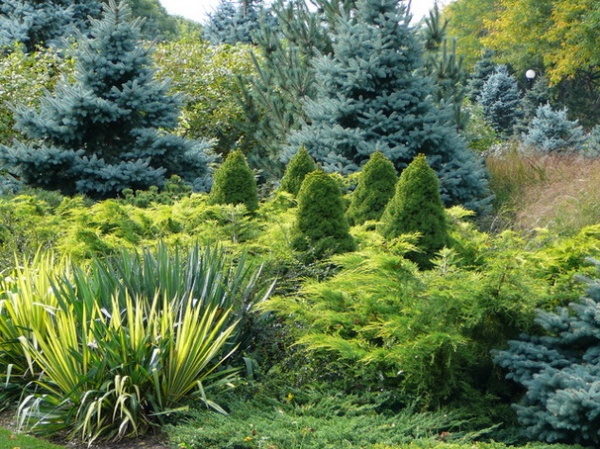
From sharp and spiky to soft and fern-like, conifers are studies in textures. These Colorado blue spruces (Picea pungens cvs, USDA zones 3 to 7; find your zone) in the background anchor this garden and exhibit a coarse texture, while the white pines (Pinus strobus cvs, zones 3 to 8) and the Alberta spruces (Picea glauca ‘Conica’, zones 2 to 7) bring in a soft, fuzzy textural quality that draws us in. The chartreuse junipers low in the foreground have a deceptively soft, airy quality, as these are, in fact, less desirable to touch.
It is the artistic blending of these textures that gives this garden depth and interest. It is what makes you pause to take a second look. Like an artist uses a variety of brushes, paints and palette knives to craft a painting, you can use a variety of conifers as your tools to craft a sensual and personal garden. Here are some suggested plants with which to stock your palette.
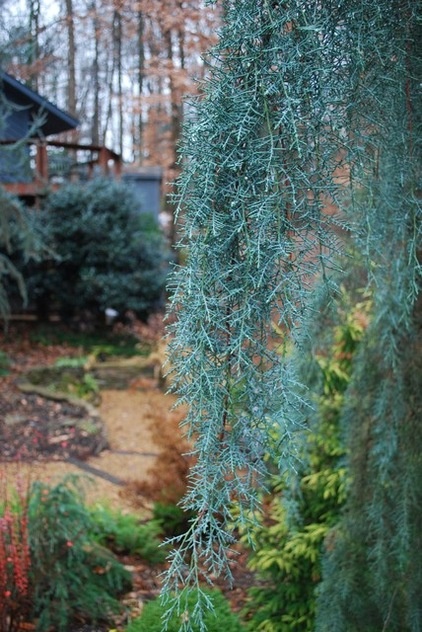
Evergreen cypresses. Cypresses, such as this Raywood’s Weeping Arizona cypress (Cupressus glabra ‘Raywood’s Weeping’, zones 5 to 9), exhibit a texture similar to that of a rough-woven fabric. The fact that many of these cypresses sport colors of blue or chartreuse only enhances their value in our gardens.
Creating a vignette by planting Raywood’s Weeping with a trio of shaggy globose dwarf pines or low-growing chartreuse junipers planted en masse would make a textural statement worth remembering.
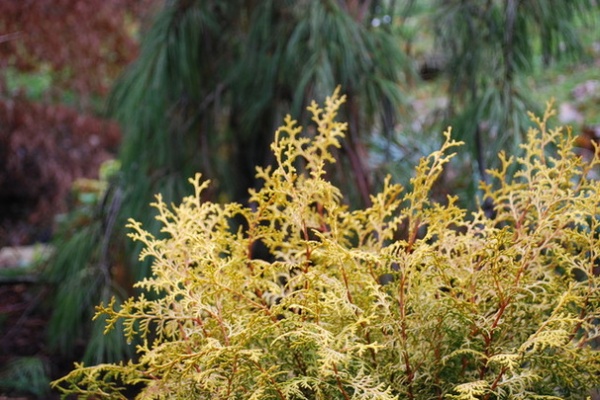
Hinoki false cypresses. This tree, known botanically as Chamaecyparis, is related to cypress and generally exhibits the same fine texture. There are two major types of Chamaecyparis: pisifera and obtusa. Pisifera is enerally blue in color and has a coarser, more rounded type of foliage, whereas obtusa’s foliage is generally softer and flatter. Both are excellent tools in creating an artistic garden composition.
This Lucas hinoki cypress (Chamaecyparis obtusa ‘Lucas’, zones 5 to 8) has beautiful soft, flat, fern-like foliage. With its yellow foliage and reddish stems, Lucas earns its place in a sunny or partially shady garden. Here it is shown against the contrasting blue foliage of Angel Falls weeping white pine (Pinus strobus ‘Angel Falls’, zones 3 to 8).
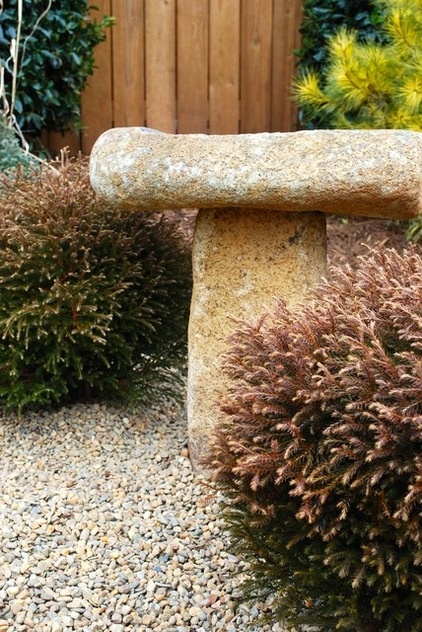
Arborvitaes. The arborvitae is another member of the cypress family and a useful tool in creating artistic textural gardens. Like the Chamaecyparis, it generally exhibits flat, textural fern-like foliage. While we generally picture the taller pyramidal arborvitaes that are commonly used for hedges, there are several dwarf and rounded forms available. Mr. Bowling Ball (Thuja occidentalis ‘Bobozam’, zones 3 to 8) and Little Giant (Thuja occidentalis ‘Little Giant’, zones 3 to 8) are two suggested cultivars.
The three Mr. Bowling Ball arborvitaes shown here play off the textural stone birdbath and take on a sculptural quality, planted unexpectedly in a gravel seating area.
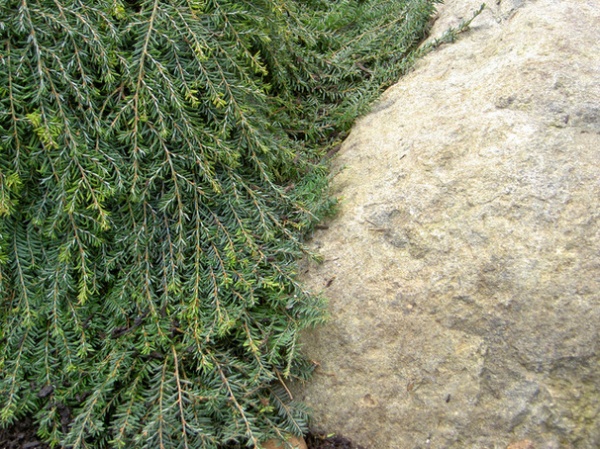
Hemlocks. These shade- to partial-shade-tolerant conifers exhibit fine, semisoft foliage. The foliage conjures up images of herringbone-patterned fabric.
Tall standard, weeping, dwarf and even prostrate forms are available, making this plant adaptable to a plethora of uses in the garden. Weeping hemlocks are an obvious choice for planting over boulders and waterfalls.
Variegated cultivars, such as Gentsch White (Tsuga canadensis ‘Gentsch White’, zones 3 to 7), and yellow forms, such as Golden Splendor, are available.
Hemlocks are susceptible to infestation by the wooly adelgid in certain areas of the U.S. This insect can be controlled systemically or by foliar spraying if necessary.

Pines. These trees are go-to plants in garden design. Pines generally exhibit narrow, erect foliage. Their sculptural quality has made them a staple in Asian gardens for centuries.
This large and diverse family includes black pines, such as Thunderhead (Pinus thunbergii ‘Thunderhead’, zones 5 to 10); white pines (Pinus strobus and Pinus parviflora, zones 3 to 8 and zones 5 to 8, respectively); red pines, such as Dragon’s Eye (Pinus densiflora ‘Oculus Draconis’, zones 4 to 7); and Scots pine (Pinus sylvestris cvs, zones 2 to 7).
Some of the newer pine cultivars, such as this Mini Twists (Pinus strobus ‘Mini Twists’, zones 3 to 8), exhibit contorted foliage that brings additional textural interest to the garden.
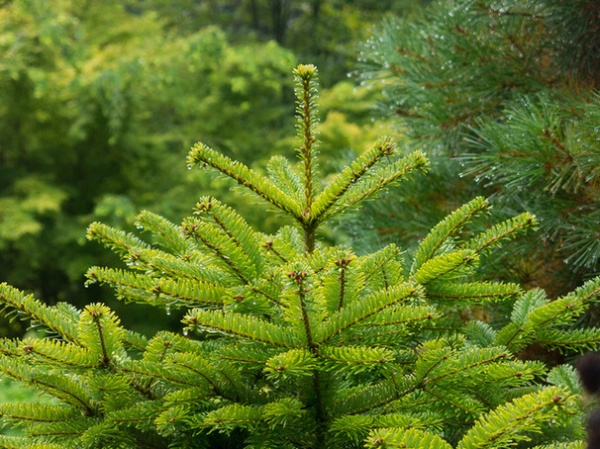
Firs. These conifers are prevalent in the Pacific Northwest and have short, upright needles that contrast well with the weeping or contorted foliage found on some hemlocks, pines and cedars. Additionally, some firs, such as this Golden Spreader (Abies nordmanniana ‘Golden Spreader’, zones 4 to 7), have chartreuse foliage that brightens up a lightly shaded garden.
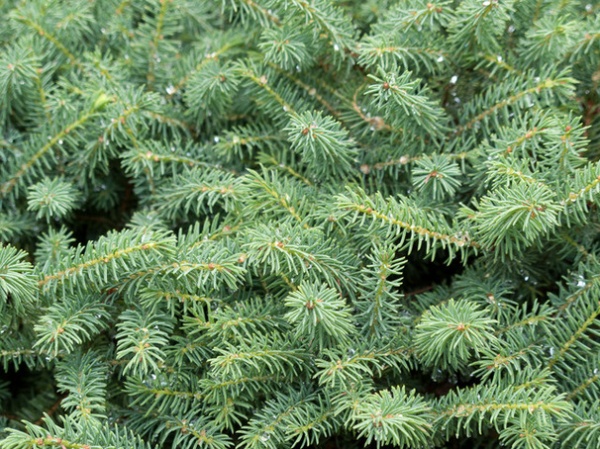
Spruces. These conifers generally have stiff, short needles that are arranged in a 360-degree pattern around the branch, as opposed to fir needles, which are generally softer and grow on the upper portion of the branch only. Additionally, spruce needles have four sides and are easy to roll between your fingers; fir needles have two sides. All spruces are quite textural.
Some spruces, like this blue nest spruce (Picea mariana ‘Ericoides’, zones 3 to 9), are mounding in form. Others are tall standard, weeping or contorted. Consider pairing nest spruces with narrow, upright conifers, such as Chirimen hinoki cypress (Chamaecyparis obtusa ‘Chirimen’, zones 5 to 9).
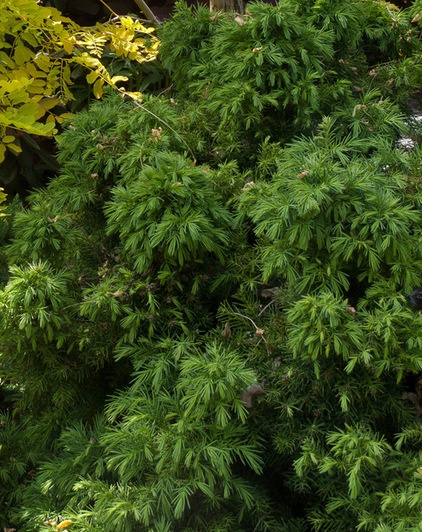
Japanese cedars. Cryptomeria japonica (zones 5 to 9) is the national tree of Japan. Legend has it that the spirits of ancestors inhabit the trunks of these majestic trees. They are generally characterized by soft, dense dark green foliage arranged in a cloud-like pattern. Some are tall and pyramidal, reaching to 80 feet, while some, like ‘Dragon Prince’, are globose, reaching a height and width of 3 feet. Consider planting them with blue spruce for a textural vignette.
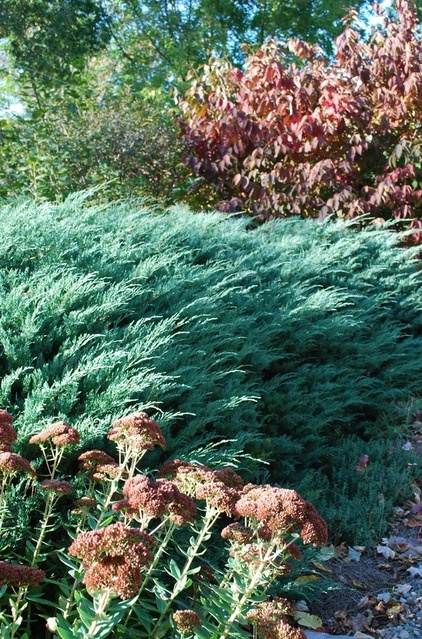
Junipers. This group of shrubs and small trees is probably the most maligned group of conifers in existence. Highly textural, many juniper s— like this Grey Owl cultivar (Juniperus virginiana ‘Grey Owl’, zones 2 to 9) — exhibit sharp foliage that conjures up painful childhood memories of hiding in the bushes.
Many of the newer juniper cultivars are user friendly and highly recommended. For color and texture, junipers are unsurpassed. Consider planting them with columnar spruces or firs for contrast.
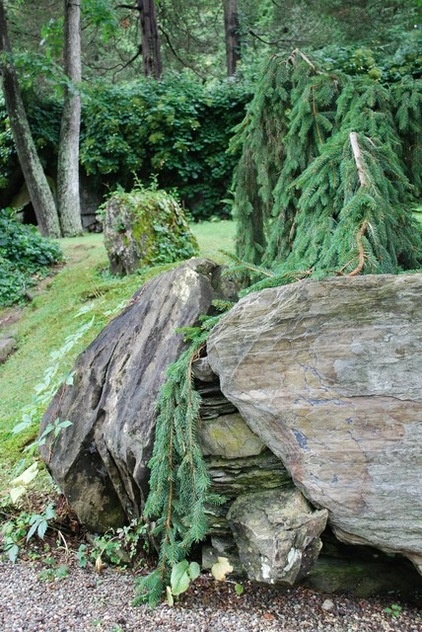
How to Use Conifers to Emphasize Texture
Contrast with hardscaping and art. Conifers can be used to contrast a hardscape; doing so further highlights their texture. This weeping Norway spruce (Picea abies ‘Pendula’, zones 2 to 8) contrasts beautifully with these highly textured boulders. Notice how the vertical lines of the spruce draw the eye to notice the horizontal and vertical texture of the stone.
Conifers can also complement and contrast sculpture and oversize pottery with great effect.
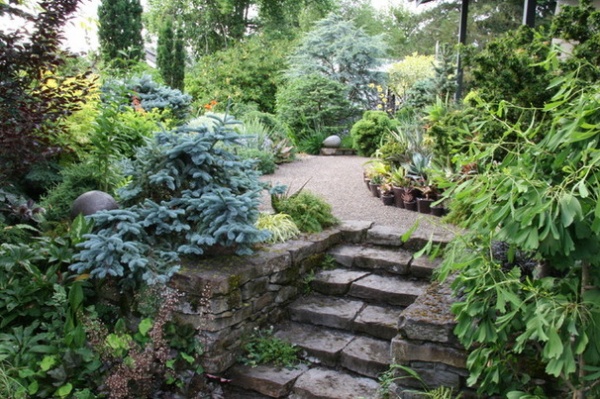
Highlight mixed beds. When used in this way, conifers contrast beautifully with other bedmates. Frequently, in fact, their high contrast with neighboring plants elevates them to the status of living sculpture.
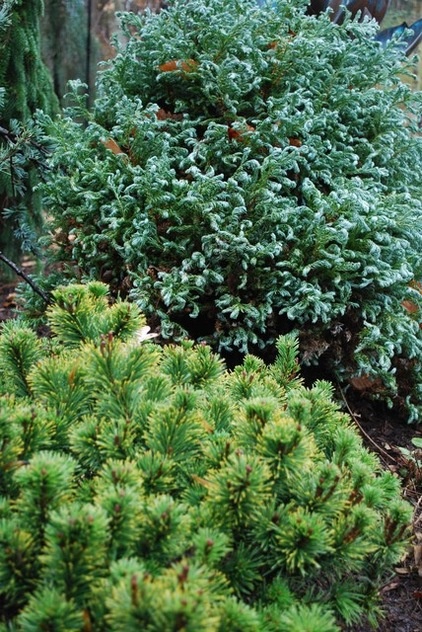
Contrast conifers with one another. Because conifers have such varied sizes, shapes, colors and textures, it is exciting, and often intimidating, to use them together to create vignettes of high contrast and interest. Bedmates such as this Slowmound mugo pine (Pinus mugo ‘Slowmound’, zones 2 to 8) and this Curly Tops false cypress (Chamaecyparis pisifera ‘Curly Tops’, zones 4 to 8) provide year-round structure and high contrast based on size, shape, color and texture.
Don’t be shy about using different conifers in close proximity. Your garden may just thank you.
More in this series:
Exploring conifer shapes
Exploring conifer colors
Related Articles Recommended












